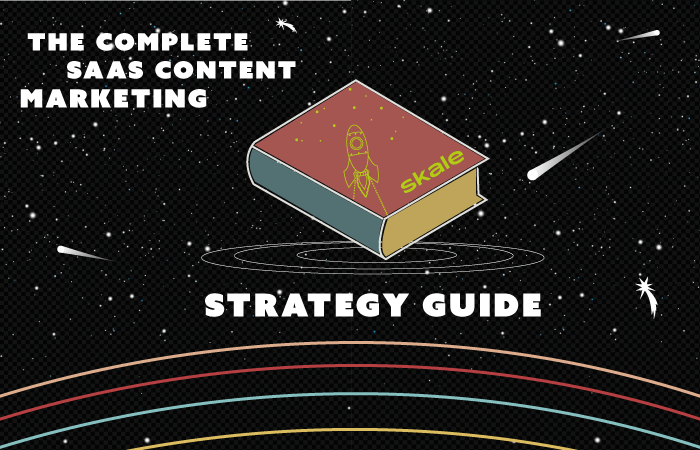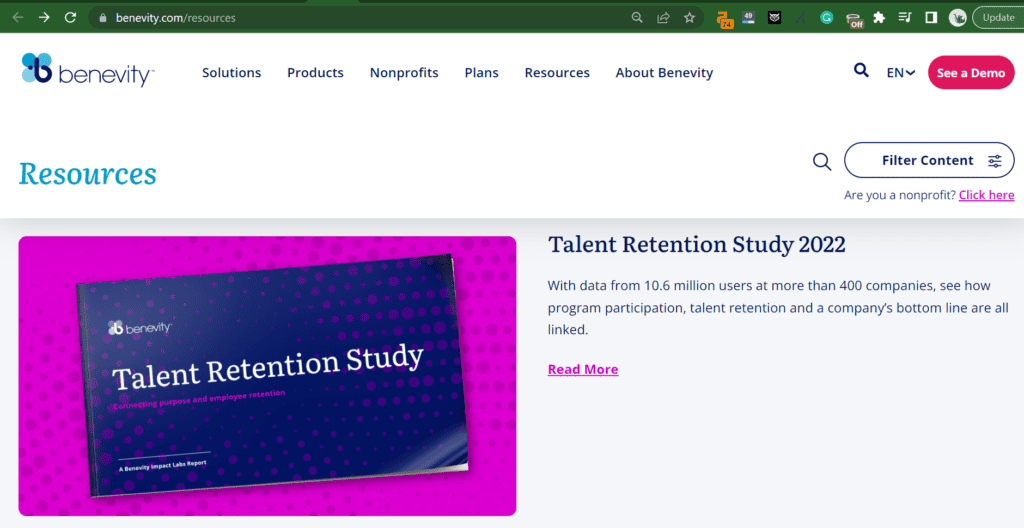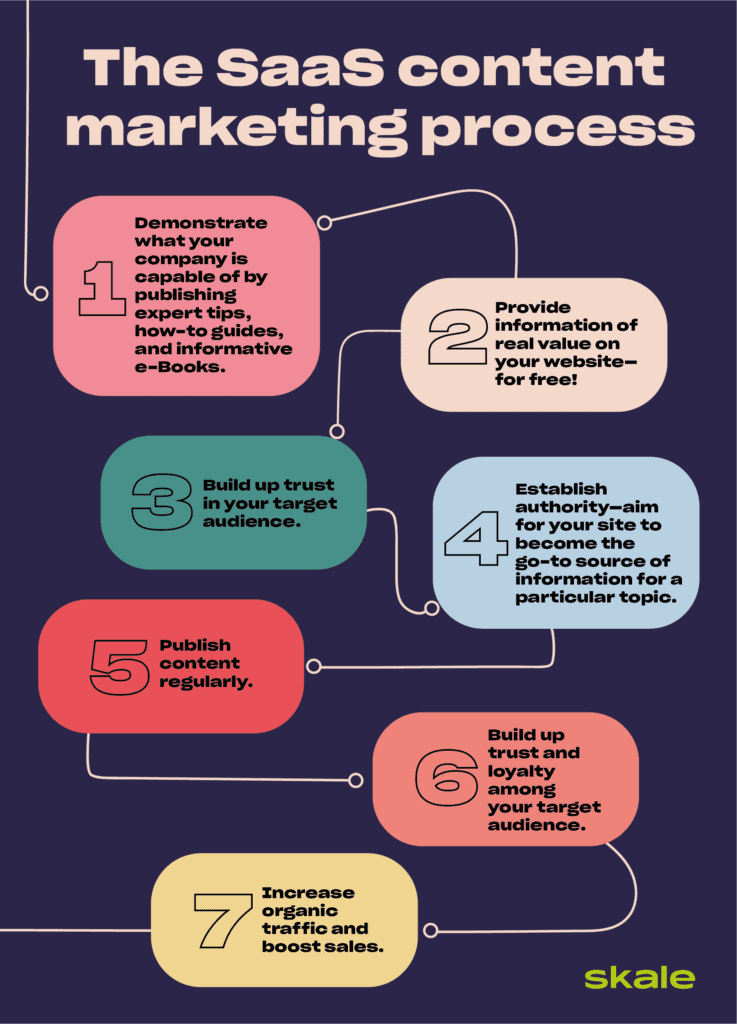
The best 8 SaaS marketing events to attend in 2024
In this comprehensive guide, we'll showcase some of the best SaaS marketing events in 2024 that you shouldn't miss.


Content is king, queen, and everything in between. We know it, you know it, buyers of today know it. Quality content builds brand reputation, brand sentiment, and trust, and ultimately, it ups your SaaS sales.
Understanding the type of SaaS content pieces you should be creating is one thing, but actually creating and delivering it to your target audience is a whole other ballpark.
So, what did we do? We took it to the experts. In this article, we spoke to nine members of the SaaS Collective, all SaaS content marketers, to get their know-how on building and managing a successful SaaS content marketing strategy that wins customers.
Good question. Here’s what we’ve learned over the years: a great SaaS content marketing strategy will solidify your brand’s online presence, becoming a go-to source of information and advice for potential customers. Here are the top benefits:
SaaS content marketing is more than just a way for users to get to know your product; it’s an opportunity for them to connect with you. By interacting with your content, they’ll get to know your brand, product, and what problems they have that you can solve.
If that’s not enough, consider this: without a content marketing strategy, you’ll find it harder to meet consumer expectations. Consistent, quality content is no longer an option when you’re battling other brands (and their blogs) for the #1 spot on Google – it’s a necessity. It can feel like an uphill battle, but we’re here to help with expert advice from experienced SaaS content marketers.
Check out these SaaS Content Marketing Agencies
Content marketing, you fickle beast. Hopefully, you’re ready to conquer it? These best practices for improving SaaS content marketing are approved and tested by our SaaS experts for various successful B2B SaaS companies worldwide.
Here we’ve laid out some of the top tips to kickstart your SaaS content marketing strategy. As a SaaS business, you have a range of content formats you can leverage, from blog posts and SaaS content writing (a pillar of SaaS content marketing) to interactive videos, guides, and ebooks. Learn from these tips, adapt them to your own SaaS product and customers, and if you have any questions, then reach out to us!
The blog is dead! Well, not really, but like a phoenix from the ashes, it’s reborn. It’s time to ditch the idea and naming of a blog and make the jump to a magazine if you want to rank on Google.
Create a SaaS brand magazine at <brandname>.com/magazine/. These are where your thought leadership content pieces will live. These pieces will position you as leaders in your niche and entertain your target audience.
There are a few brands out there that are doing this exceptionally well. Check out Wealthsimple as a great example of this.
The idea of your SaaS magazine is to take and build on exactly that concept: a magazine. Create content pieces that people enjoy and would happily pay for.
You’re not writing for search engine optimization, and Google — at least not directly—you’re writing for your ICP and target audience. What do customers want to read? What do they need to read? And, what are you in a position to uniquely write?
At the same time, deliver the full magazine package. Accompany your copy with strong, unique visuals. Steer clear of Unsplash, please! We’ve all been guilty of it (us too — here at Skale). If you can create SaaS content with unique and relevant visuals, it will lift your magazine’s experience and value.
Next up, create a dedicated section on your website for company news and product updates. Don’t just post them on a “blog.” Google is bored of blogs. These updates and company news features are not part of your company blog, nor are they for your typical magazine reader.
We don’t buy a copy of The Economist to hear how they’ve updated their company subscription models; we buy it for the content.
ActiveCampaign has an entire section of its website dedicated to product updates. It sits separate from the rest of their content and is a great example of a content site structure that others should follow.
Next, for your SEO demand capture content, it’s time to become the expert and shout about it. Build out content hubs for each identified topic that your SEO keyword research deems you need to be a leader of.
Benevity (formerly known as Alaya Good) is doing a great job of this with the content strategy that we helped put together for them. As a purpose-driven employee engagement SaaS platform, Benevity has identified pillar content topics they need to be ranking for and writing about.
Benevity breaks its content down into these pillars with a selection of articles that deep dive into each one. Benevity breaks them up depending on the reader’s intent and awareness level.
They then combine all of this great information into complete downloadable guides. It’s the perfect example of demand-capture content in full swing.

“We’ve adopted the content pillar strategy so that our target audience can more easily find and navigate based on the topic they’re interested in. It’s also great for search engines to find these pages— because even on our internal webpages, they’re all pointing to this hub for a specific topic, sending clear signals to search engines saying, “Hey, look over there, that’s where you’ll find the treasure!”
– Stephanie Grawehr, Marketing Manager @ Alaya Good.
The last thing on your list? Delete brand.com/blog/ !
— Idea provided by our very own: Jake Stainer
There are no big secrets to great content marketing and a killer content strategy. The content marketing community is very open with its successful methods, playbooks, and strategies. What there is, is unique execution.
It’s a great idea to use your customers when creating content pieces. Understand customers’ pain points, and create content that answers those customer pain points.
“Too many companies over-index on generic SEO content marketing that ranks for high search volume queries, which is good, but they don’t spend enough time creating niche content pieces that their customers will value.”
Look to build things like company leadership reports, host statistics, and write articles that engage people — more so than these generic articles trying to hit keyword research.
Find the balance, and use quantitative and qualitative user data to forge content that’s valuable, unique, and educational.
— Idea provided by: Kevin Indig, Growth Advisor – ex-Shopify, G2, Atlassian
Many SaaS marketing teams fail to put as much effort into distributing their content as they do with the creation. Think about it; you spend hours, days, maybe even weeks putting together an incredible article, and then you let it sit still in the water.
It’s time to make waves and push that article into the hands of potential customers.
“The way I’ve been thinking about it and explaining it to other people, as you can just shovel your cake ingredients into a bowl and hope to win the Great British Bake Off, you have to have to put it in the oven. You have to present it.”
“If you put the time into the creation of your company content, it could be the best article in the world, but if you’re not putting the time into distribution and promotion, you don’t have much chance of getting anywhere after that. Promotion can be an outreach campaign. It can be social media, email marketing, newsletter features, whatever you’ve got to work with.”
Take your distribution strategy a step further and create content that resonates with the channel you’re using to share your article on.
For example, let’s say you have an epic article on Content Marketing for B2B SaaS and want to promote that article on LinkedIn. In this example, you could transform a snippet of that article into video content and share it via a post. Knowing that LinkedIn users are 20x more likely to share video content.
Find the channel, adapt to the channel, whet the appetite, and win click-throughs.
“I also think it should also be on the writer’s to-do list to put the time into the promotion of the article as well. They should be proud of the work they’ve created and want to share it.
Even for the articles I write, I put together an outreach campaign. I think it works a little better if I’m doing it on a personal level too. For example, I’ll say I drank twenty-five coffees writing this article, make the caffeine shakes worth it, and let me know what you think!”
— Idea provided by Kirsty Finlayson, Head of Marketing @ Chameleon
There are tons of different ways to research your article. There are plenty of SaaS tools out there to help you get the job done, too, a few of which you’ll find at the end of this article. You can also check out our piece on SaaS SEO Keyword Research Methods for more.
One of the best ways to do qualitative research, if you have the time, is to search for the topic/keywords you’re trying to rank for on Google. Take some time to read over the top ten articles out there.
“Generally, you’re going to be met with quite a lot of rubbish out there still ranking on the first page in SERP.”
Go through each article and ask yourself what you like and what you don’t like about that article. Write down the pros and cons of each article and identify how you can do it better.
“Ask yourself, what are competing articles doing that you can one-up and is still going to meet user search intent? Think about how you can make that article shine.”
If you’re briefing a freelance writer, highlight the top articles and why you don’t or do like them. This research should make for a more informed piece and one that not only hits intent but has a strong competitive edge to help it outrank the current reigning Google champions.
Many SaaS companies confuse or don’t segment their keywords when working on their content strategy. They pick keywords that are relevant to their audience but don’t take it any further than that.
This research means companies have relevant keywords but are unsure where these keywords come in the customer journey and which words resonate with buyer intent. Conversion keywords are your money keywords and need unique content around them.
Identify your conversion keywords by working closely with your PPC team when conducting all of your keyword research. The PPC team has fantastic data sets on what they’re bidding on and what search queries are converting for the business.
“A common company mistake is looking at keyword volume instead of focusing on things closer to people making the decision to buy. Focus on intent-based keywords with low volume. For example, conversion to a free trial or even paid plan subscription.
Take a keyword that works, then find all the long-tail keywords that have even lower search volume but higher intent.”
For example, for ‘SaaS Content Marketing,’ our longtail keywords are:
Just from that, we’re already making this article more competitive — although you can decide if they’re conversion keywords or not. 😉

Level up your SaaS keyword research
Learn how you can scale your SEO ROI with a great keyword research strategy.
Read the guideLastly, add personality to the content you’re creating. If you’re writing for conversions, you’re giving a strong insight into what life would be like for someone if they become a customer. You’re delivering an inclusive tone that sheds light on customer success relationships.
Exemplify the brand you want to be and the internal treatment a customer can expect. It will forge relationships and help a reader visualize the greener grass on the inside.
— Idea provided by Vassilena Valchanova, Digital Marketing Strategist.
Whether it’s branding, data, great company imagery, or something else, give your SaaS content marketing examples the best opportunity possible to win backlinks. Try to get picked up and noticed for the content you’re putting out there and work on building organic SaaS backlinks for quality.
What’s more, you don’t just need to win backlinks for the quality of content you provide that’s specific to your niche. You can win backlinks for how you’re conducting your marketing efforts, how your marketing operations run, or for the exemplary style you’re putting out there.
Don’t just think that you’re winning links within your field. You can win links from SaaS marketing agencies, like us, notable awards brands like The Drum, or even graphic designers that appreciate the visuals you’re coupling with your content.
Keep your quality and creativity high across the board and get those mentions, shares, and links that your SaaS business deserves.
Create a total content marketing experience and journey for customers. You can’t jump straight to 100mph in an introduction, and at the same time, you can’t be dragging your heels and saving the good stuff for your final punchy paragraph.
Hook people from the first moment, and keep building their interest throughout the piece. Keep speaking! 🏔️
“Most businesses think that an interesting introduction to any content is enough to attract consumers. It’s not. You have a piece of content, and whether it’s an email, article, or video format, you have the desired action you want the consumer to take. Scheme your content in a way that it keeps getting more and more interesting until your CTA.”
This way, you turn a neutral consumer into a hyped-up, guaranteed lead by the time they reach your CTA. Plus, you’ll decrease the bounce rate and improve your lead conversion in the process.
— Idea provided by Selman Gökçe, Inbound Marketing Specialist @ UserGuiding
“A lot of SaaS companies still ignore the fact that people search for their solution when they already consider buying it. For example, a digital marketer is asked to find an email automation tool. They’ll likely search for this exact term in Google — or even the name of a tool recommended.”
Any marketing consultant will say the same, the content you create to answer this search intent isn’t the type of content that attracts a wide audience.
“As SaaS content creators, we need to focus on the problem(s) and pain points that our product solves. For example, that email marketing tool can help us: nurture leads, write better emails, or create a newsletter (just to name a few).
When we focus on the problem at hand for our content marketing plan, we reach wider audiences while remaining relevant to potential buyers.”
SaaS content marketing is not landing pages; it’s building funnels to get there.
So in this email marketing solution example, it’d be worth writing content about:
These aren’t massively unique examples, and you can certainly create more intriguing subjects depending on your niche, but let’s focus on the thinking model here.
Next, make these articles 20% about your SaaS product in the context of helping to solve that problem, and 80% info they can use without your SaaS product.
Depending on how specific you get with your problem will depend on how close to conversion you get with readers. When you’re super specific, you’re more likely to convert yet less likely to reach a wider audience.
Define a goal for each piece of content, metrics to measure that goal, and write for problems that hit that goal.
— Idea by Pawel Banhegyi, Founder at Map My Growth
It’s always so important to remember your reader and their role in SaaS content marketing. The higher up the chain of command your target audience is, the less time they’ll likely have to read or consume long-form content.
If you’re trying to reach Heads of Departments, Directors, CEOs, or COOs, for example, you need to find other ways to make an impression.
“Try delivering leadership roles with bite-size tips or pieces of info instead of ebooks, webinars, or blog posts. Things like 1-3 min explainer videos, weekly newsletters packed with actionable tips, or punchy social media posts with one key takeaway.
Focus on delivering consistency over time, and you’ll make sure your SaaS brand leaves a deep impression that way, rather than one epic skyscraper post they stumble upon.”
At the same time, if you’re trying to target specialists, assistants, or coordinators, you can put together more long-form content. These are the types of roles that set aside time to do their research and really dive in to make sure they’re working as efficiently as possible.
Although these people may not have direct access to the cash flow to purchase your SaaS product, they can be your internal brand champion and push your case forward.
There’s no right or wrong level of seniority to aim for when it comes to SaaS marketing; it just depends on the content you’re delivering to both.
— Idea by Eden Bidani, Marketing & Acquisition Specialist @ Greenlight Copy.
Firstly, look for great writers that know what they’re talking about. Onboard them, so they fully understand your product, your target audience, and the area of the marketing funnel they are writing for.
Use TOFU content to bring in your target market, BOFU content for brand alignment, and push a unique POV within the market.
When you optimize marketing content for MOFU, it’s when you can find incredible success. When you meet people when they need you and a solution you have, that’s when the important SEO work comes in. Especially if you’re in a saturated market, figure out where you’re going to pin your focus and lead this content with SEO.
“When I started out at a previous role we just weren’t seeing the click-through rates we’d hoped for with our TOFU content. The issue was, the content wasn’t focusing on the benefit that our product gave the client.
We began to reframe our TOFU marketing content for the benefits of what the product does, not the product itself, and we saw much more engagement and click-throughs with our TOFU content.”
Each section of the funnel should have a different goal, and therefore different content to help people reach that goal.
— Idea by Meagan Healey, Director, Marketing & Communications @ Dig Insights

Learn from Skale’s SEO wins
See how we 10x’d product signups for Piktochart in just 3 months.
Read the case studyBuilding trust and credibility is at the core of every successful SaaS marketing strategy. When potential customers see that a particular business is consistently sharing valuable insights and actionable strategies, they’re more likely to consider that business as a thought leader in the industry. Providing reliable and accurate solutions to common pain points is a top tip. Thought leadership is essential to building your reputation in the SaaS world.

Sharing expertise in your specific area is also crucial to optimizing search engine visibility and organic traffic — the information you can share will help attract potential customers across countries and industries. When it comes to performing well on Google, your SEO strategy must be geared towards meeting its E-E-A-T guidelines, which stand for Experience, Expertise, Authoritativeness, and Trustworthiness. This can be achieved in a number of ways, like making it easy to verify the accuracy of the information on your site, demonstrating expert opinion and quotes as far as possible, and showing the real organization behind the website.
The great thing about demonstrating expertise is that, once you’ve gained the trust of your readers, you can promote your product or service as the best solution to a specific challenge or pain point. By describing its value, you can help potential customers understand the relevance and potential impact of the SaaS offering, increasing their interest and likelihood of conversion.
Crafting an effective content distribution strategy is just as important as creating the content itself. It’s crucial to plan how your content will be promoted even before you start creating it.
There are three main methods for distributing content:
It’s important to remember that each channel and platform within these categories has its own guidelines and best practices for sharing content. This means that your content needs to be tailored and adapted for each specific platform.
If you get it right, your content will receive a lot of exposure and engagement. However, if you don’t consider the platform-specific requirements, your content might go unnoticed. For example, long-form blog posts are not compatible with Instagram or Twitter, but you could adapt them into smaller, more digestible chunks of information using infographics. It’s essential to adapt your content to fit the unique characteristics and audience of each platform.
Content marketing in the SaaS world is no easy task. It’s saturated, rife with quality, but also rife with opportunity. If you do your marketing research well, you’ll be able to start creating marketing content that wins trust, clicks, and conversions. Working with a respected content marketing agency, such as Skale, is a good place to start.
It’s important to set marketing goals and marketing metrics you want to track. When you come from data-driven decisions, you’re able to make more accurate content that answers problems and needs and organically introduces your product. Remember to put the customer first, the problem second, and the solution last. Focus on quality, remain consistent, and let your ICPs come.
In short, the best SaaS content marketing strategies boil down to:
If you’re looking for further insights into creating a SaaS content marketing strategy that works for your business, why not schedule a chat?
Bonus read: How to Perform a Content Audit for SaaS Brands?
SaaS Content Marketing is a strategy for how Software-as-a-Service businesses build awareness and sell their products. Content Marketing includes blogs, newsletters, emails, social media, videos, AR & VR experiences, podcasts, infographics, videos, and more.
Content Marketing for SaaS businesses will usually focus on the benefits the product can bring for the customer, help to build brand loyalty and trust and support various parts of the customer journey and sales funnel. Interested in finding out more about where content marketing can take your SaaS business? Book a call with Skale today.
SaaS content marketing is a more sustainable way of promoting and selling your SaaS product. It works because it builds your organic growth via non-paid marketing channels. SaaS content marketing also focuses on more long-term growth utilizing evergreen content that will only get more popular over time. Want to know more about what a content marketing strategy can do for your SaaS business? Chat with us today.
SaaS content marketing should be at play throughout every step of the buyer journey. From the top of the funnel (TOFU) to middle of the funnel (MOFU) and bottom of the funnel (BOFU). The SaaS content market can help every stage of the customer lifecycle, ensuring a well-rounded and personal customer experience.
Our favorite tools for successful content marketing are:
1. Maze—for user research
2. Chameleon—for in-app content
3. Sprout—for social media management
4. Piktochart—for infographics & quick designs
5. Happy Scribe—for video & audio transcripts
6. Zapier—for tool integrations
7. HotJar—for user behavior analytics
8. Mailchimp—for email marketing management
9. Autopilot—for content marketing automation
A content marketing strategy is best organized via a central knowledge base. This knowledge base should store all external links to relevant info and tone of voice (TOV) guidelines, consumer behavior research, competitive analysis, and anything else that may aid your overall content marketing strategy. Slite is a great tool for this.
Learn more about
SaaS Marketing

The best 8 SaaS marketing events to attend in 2024
In this comprehensive guide, we'll showcase some of the best SaaS marketing events in 2024 that you shouldn't miss.

7 Best SaaS Copywriting Agencies & Services in 2024
11+ SaaS copywriting agencies that will educate your audience, boost revenue, and nurture leads.

9 SaaS Content Marketing Agencies in 2024: Reviews & Pricing
Create content that generates serious revenue when you work with a SaaS marketing agency from this list.